Issue 11, September 9, 2021
Fall Armyworm in Turfgrass
Large populations of fall armyworms (Spodoptera frugiperda) are being seen throughout the eastern US. This species has a broad host range including corn, wheat, soybeans, vegetables, and fruit trees in agricultural areas; trees, shrubs and flowers in landscapes; and bermudagrass, Kentucky bluegrass, fescues and ryegrass in turfgrass areas.
Fall armyworms move through an area feeding in groups. When they have consumed all the food in one area, they may move on to another. It is common to see fall armyworm larvae move from cornfields or fields of small grains into nearby turfgrass areas.
Fall armyworms are unable to overwinter in Illinois. Each year, the adults fly northward from warmer regions (including Texas, Florida, Central America and the West Indies). While they may have up to 11 generations in the warmer portions of their range, in Illinois, they have 1-2 generations in late summer and early fall.
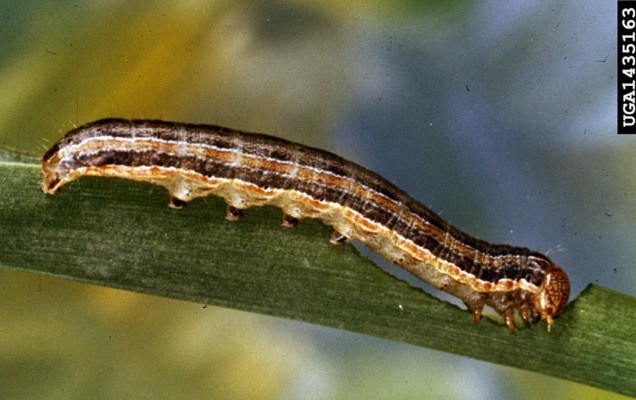
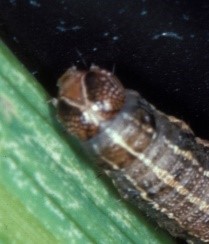
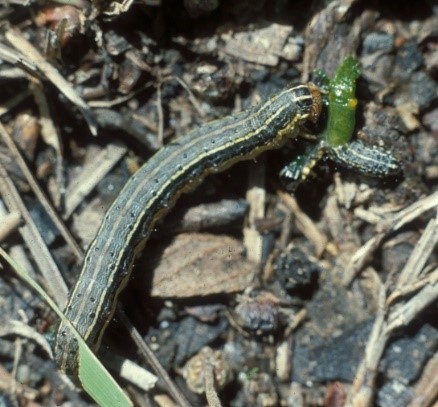
Left: Fall armyworm (Spodoptera frugiperda) larva, Clemson University - USDA Cooperative Extension Slide Series, Bugwood.org
Center: Fall armyworm larva showing Y-shaped marking, Frank Peairs, Colorado State University, Bugwood.org
Right: Fall armyworm larva eating another larva, Frank Peairs, Colorado State University, Bugwood.org
Because similar species can be confused with fall armyworms, like armyworm (Mythimna unipuncta), common armyworm (Mythimna convecta) and yellow striped armyworm (Spodoptera ornithogalli), it’s important to identify which species you’re dealing with.
Larvae grow up to 1 1/3 inch long. They vary in coloration with some being dark green, tan or brown. They can be distinguished from other caterpillars by the Y-shaped marking that runs from the top of its head down between its eyes and the orange stripe that runs along each side.
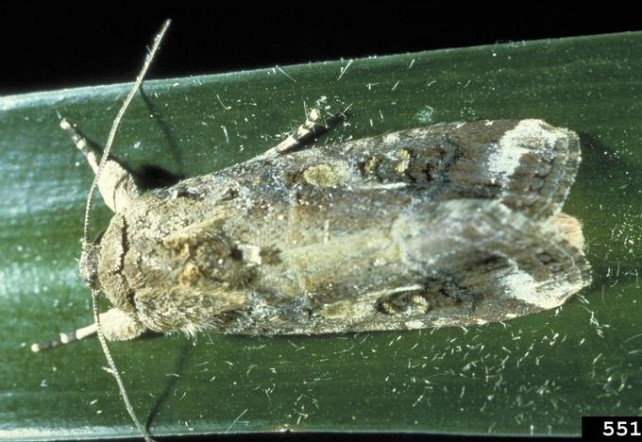
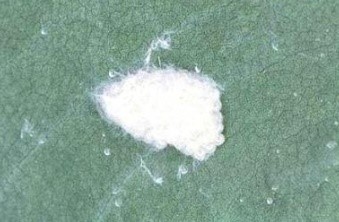
Left: Fall armyworm male moth, John Capinera, University of Florida, Bugwood.org
Right: Fall armyworm egg mass, Richard Sprenkel, University of Florida, Bugwood.org
Adults males have brown forewings with tan and gray markings and a white triangular shape near the tip of the wing. The forewings of females are brown with less distinct markings than males. Both males and females have silvery-white hind wings
Fall armyworm egg masses can be found on grass, leaves and structures in the landscape. The egg masses may contain up to 400 eggs laid in 3-4 layers. The eggs are covered in silk, giving the egg mass a fuzzy appearance.
The eggs hatch in 5-7 days. Newly hatched larvae will drop from the leaves to the turfgrass below on a thread of silk and begin to feed on the grass blades. When larvae are young, they feed on the surface of grass blades, but large caterpillars can chew the grass blades off. Larger caterpillars may even begin to cannibalize the smaller caterpillars. The larvae complete 5-6 larvae growth stages in 3-4 weeks.
Larvae feed on the grass blades, but typically do not feed on the crowns. Watering and fertilizing can give the stressed, dry plants a chance to grow new blades from the surviving crowns after the fall armyworms have been controlled.
Biological treatments, including Bt products (Condor) or spinosad (Conserve), are effective controls.
Chemical controls for fall armyworm include: carbaryl (Sevin); chlorantroniliprole (Acelepryn); clothianidin (Arena); pyrethroids like bifenthrin (Onyx, Talstar), deltamethrin (DeltaGard) or lambda-cyhalothrin (Lambda Select, Scimitar); or trichlorfon (Dylox).
There have been reports that some fall armyworm populations have not responded well to pyrethroids. It may be a good idea to begin treatment with a different mode of action or to switch to a different mode of action if pyrethroids are not controlling the fall armyworm population.
If neonicotinoids are chosen, it is important to avoid applying them to flowering plants (including clover and flowering weeds) to prevent pollinator exposure. Because these products are transported within the plant, they have the potential to harm pollinators visiting flowers on any treated plant.
Author:
Sarah Hughson